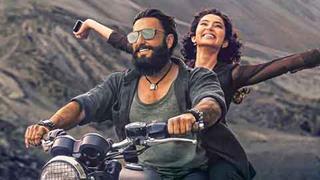Once playback singing was in place in Hindi films, elaborate filming of the numbers caught the fancy of filmmakers. The process has come to be called 'picturisation'.
Bollywood's original showman, Raj Kapoor, had the vision to picturise songs lyrically. He had a tremendous sense of music. Besides being a good dancer, he could also sing like a professional.
What's more, he grasped the cinematic idioms perfectly early on in his career. Thus equipped, he could use the art, artistes and technology like pawns in his hand.
The transition from a scene to a song in his movies was so smooth that it flowed like a river into the sea - a quality very few Bollywood filmmakers can boast of.
Shot inside studio, the song 'Ghar aaya mera pardesi' in the dream sequence in his 'Awara' creates such an illusion that it transports the audience to a rarefied world.
This particular song from 'Awara' set the benchmark for visual effects in Bollywood movies and did so at a time when there were no computer graphics to create virtual reality in movies, to make make-believe seem real.
'Pyaar kiya do darna kya', the song from K. Asif's 'Mughal-e-Azam' picturised on Madhubala with her image reflecting on hundreds of pieces of cut glass, also had a mesmerising effect on the audience.
Though it was a picture of awesome opulence, the manner in which Asif shot the song sequences became the highpoint of the movie.
Creating such visual effects in 'Awara' and 'Mughal-e-Azam' cost Kapoor and Asif quite a fortune and time. But they were makers who never compromised on anything to translate their vision for a song on screen.
One of the most popular songs of the 1970s, 'Roop tera mastana, pyar mera deewana', from Shakti Samanta's 'Aradhana', was notable for the fact that Samanta filmed it in a studio in just one take from a trolley, using the least possible material to create visual effects.
It was perhaps the only song from a successful Bollywood movie of its time to have been picturised at a minimum cost.
Today, directors like Karan Johar and Sanjay Leela Bhansali spend a good part of the total budget of their movies on song picturisations, erecting lavish sets, dressing up the characters and a hundred or more junior artistes in expensive costumes, selecting the most picturesque of locations and getting the number choreographed in the most flamboyant manner.
When they film songs in studios, they erect sets costing not less than Rs.5 million. And to think that a song lasts on the screen only for a few minutes!
Today, a song picturised on outdoor locations may cost the producer a minimum of Rs.2.5 million per day if shot in India. The songs shot abroad costs about Rs.5 million, not counting travel and lodging expenses to be incurred for taking the unit there.
While shooting outdoors in India, besides paying for the usual expenses, like the union-fixed wages to junior artists, choreographer, dancers, technicians, transport and travelling expenses, a producer invariably finds himself making unofficial payments to various government agencies like the public works department (PWD), the forest department and the local police.
Unless palms are greased, the officials from these departments may disrupt the shootings on one pretext or the other.
While shooting on the streets of Mumbai, a producer has to obtain permission from the police and the municipal corporations and officially it costs around Rs.50, 000 to Rs.60, 000 per day.
If the shooting takes place near or on sea beaches, an additional permission has to be taken from the customs department, along with a payment of Rs.10, 000 per day.
Here too, a producer generally shells out more than Rs.100, 000 unofficially per day to ensure that the officials from the departments do not disrupt the shootings. Shooting at railway stations also costs around Rs.100, 000.
The choreographer is the most important technician when a song is being picturised. For the services rendered, a choreographer commands a fee varying from Rs.50, 000 to Rs.300, 000 per song. The assistants to the choreographer get between Rs.15, 000 and Rs.25, 000 each per song.
Each choreographer has his or her own favourite dancers. Depending upon their looks, the rates of the dancers vary from Rs.4, 000 to Rs.5, 000 per day. The better-looking ones, called A-class dancers, obviously get better rates and they appear in the front row when a song is being picturised.
Nowadays Bollywood producers generally recruit aspiring models and foreigners as front-row dancers and pay them extra, ranging from Rs.12, 000 to Rs.15, 000 per day.
The costumes that the lead pair wears for a song cost between Rs.25, 000 and Rs.50, 000 per outfit and sometimes even more if the same are cut by well-known fashion designers.
The dresses that the background dancers wear generally cost Rs.2, 000 apiece. These costs may multiply if the lead pair and the dancers have changes of costumes during the song, which they invariably have these days.
The equipment required for song picturisation, like extra cameras, lights, cranes and the Jimmy Jib, collectively cost the producer around Rs.150, 000 per day.
Today, make-up vans, also called vanity vans, have become a permanent fixture during shootings. Producers have to provide them each not only to the stars but also to the cinematographers.
They have to keep at least five or six make-up vans lined up on a location. The hiring charge of these specially-designed air-conditioned vans is Rs.5, 000 per eight-hour shift per day.
All expenses put together, a song may cost a Bollywood producer around Rs.10-15 million. He does not mind it because by selling the music rights of his movie, comprising five to six songs, he may earn Rs.150 million to Rs.200 million, provided the music director has done a good job.
Bollywood on song: the whopping price tag
Friday, June 06, 2008 13:44 IST



















